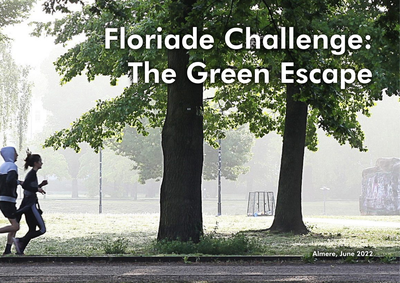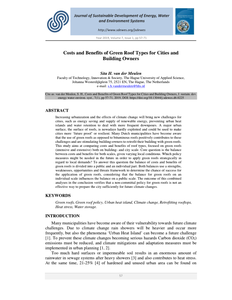Almere is a green city where the greenery extends into the centre through a framework of nature, forests, parks and canals. With this green environment, Almere fulfils an important condition for a liveable city, where it is pleasant to live and work. An important goal for the municipality is to challenge its residents to develop a healthy lifestyle by using that green framework.But what really motivates Almeerders to go outside to exercise, enjoy the surroundings and meet each other? Are there sufficient green meeting or sports facilities nearby? Could the routes that connect the living and working environment with the larger parks or forests be better designed? And can those routes simultaneously contribute to climate adaptation?With the Green Escape Challenge, we invited students and young professionals to work on these assignments together.
DOCUMENT

Green Urban Solutions is de overkoepelende benaming voor innovatieve toepassingen van groen in stedelijk gebied, zoals bijvoorbeeld groene daken, groene gevels, indoor groen en specifiek ontworpen aanplant op pleinen en perken. Ondanks de vele waarden die Green Urban Solutions genereren en het brede scala aan stakeholders die hier belang bij hebben, ontbreekt het tot nog toe aan solide business modellen voor Green Urban Solutions waarin deze stakeholders gekoppeld worden aan de verschillende waarden die ze genereren. Het doel van dit onderzoek is om drie nieuwe business modellen te ontwikkelen en een advies te geven voor het betrekken van stakeholders om deze modellen te versterken en te verwezenlijken. Hiervoor is de volgende hoofdvraag opgesteld: ‘’Wat is het Nederlandse business model voor Green Urban Solutions dat de schakel vormt met de stakeholders waar ze waarde voor creëert?’’.
DOCUMENT

VHL University of Applied Sciences (VHL) is a sustainable University of AppliedSciences that trains students to be ambitious, innovative professionals andcarries out applied research to make a significant contribution to asustainable world. Together with partners from the field, they contribute to innovative and sustainable developments through research and knowledge valorisation. Their focus is on circular agriculture, water, healthy food & nutrition, soil and biodiversity – themes that are developed within research lines in the variousapplied research groups. These themes address the challenges that are part ofthe international sustainability agenda for 2030: the sustainable developmentgoals (SDGs). This booklet contains fascinating and representative examplesof projects – completed or ongoing, from home and abroad – that are linked tothe SDGs. The project results contribute not only to the SDGs but to their teaching as well.
DOCUMENT

Increasing urbanization and the effects of climate change will bring new challenges for cities, such as energy saving and supply of renewable energy, preventing urban heat islands and water retention to deal with more frequent downpours. A major urban surface, the surface of roofs, is nowadays hardly exploited and could be used to make cities more ‘future proof’ or resilient. Many Dutch municipalities have become aware that the use of green roofs as opposed to bituminous roofs positively contributes to these challenges and are stimulating building-owners to retrofit their building with green roofs. This study aims at comparing costs and benefits of roof types, focused on green roofs (intensive and extensive) both on building- and city scale. Core question is the balance between costs and benefits for both scales, given varying local conditions. Which policy measures might be needed in the future in order to apply green roofs strategically in regard to local demands? To answer this question the balance of costs and benefits of green roofs is divided into a public and an individual part. Both balances use a strengths, weaknesses, opportunities and threats framework to determine the chance of success for the application of green roofs, considering that the balance for green roofs on an individual scale influences the balance on a public scale. The outcome of this combined analyses in the conclusion verifies that a responsible policy and a local approach towards green roofs is necessary to prepare the city sufficiently for future climate changes. http://dx.doi.org/10.13044/j.sdewes.d6.0225
MULTIFILE

Overcoming Challenges in local green H2 economies Organizer: Dr Beata Kviatek, Jean Monnet Chair in Sustainable EU Economy, Centre of Expertise Energy / International Business School / Hanze University of Applied Sciences Groningen, the Netherlands One of the main pathways of the current energy transition includes development of regional green hydrogen economy, usually based in the so-called hydrogen valleys. The development of regional green hydrogen economies enables to green up regional industry and mobility, brings new business opportunities for local and regional businesses, redirects regional investments and financial streams, and proposes new avenues for regional education, knowledge, and research institutions. However, the complexity of regional transformation towards green hydrogen economy, poses challenges that require a close cooperation between different local and regional stakeholders at multiple levels, including national and European. What are these challenges in developing regional green hydrogen economies here, in the northern part of the Netherlands, and in other regions of Europe and what are the new pathways to overcome challenges in regional green hydrogen economies? – is the main question of the proposed panel discussion that will involve academics, policy makers, and practitioners from the northern part of the Netherlands as well as some European regions.
DOCUMENT

With the beautiful new building of Aeres University of Applied Sciences Almere in the Floriade park, we have materialized our wish to lead the way in the green transition and its challenges. We want to be green changemakers and have the ambition to take on the challenges that we are faced with in agriculture, food and healthy living environments. We bring this about with our study programmes and increasingly with our Practice-Based Research Team. In 10 years’ time, this team has grown from our first professorship into a mature team of 20 people, of whom 7 are research professors.In this edition, three of our new professors will be introduced to you.
DOCUMENT

Universities have become more engaged or entrepreneurial, forging deeper relations with society beyond the economic sphere. To foster, structure, and institutionalize a broader spectrum of engagement, new types of intermediary organizations are created, going beyond the “standard” technology transfer oces, incubators, and science parks. This paper conceptualizes the role of such new-style intermediaries as facilitator, enabler, and co-shaper of university–society interaction, making a distinction between the roles of facilitation, configuration, and brokering. As a case study, the paper presents the Knowledge Mile in Amsterdam as a novel form of hyper local engagement of a university with its urban surroundings that connects the challenges of companies and organisations in the street to a broad range of educational and research activities of the university, as well as to rebrand the street.
DOCUMENT

This booklet reports on experiments carried out by Van Hall Larenstein University of Applied Sciences in the context of the VALUE project. It consists of three parts. The first two chapters describe some experiments carried out in the Dutch town of Amersfoort and the students’ input and approach. This is followed by an intermezzo on sources of inspiration outside the Netherlands and examples of the way urban green spaces and elements can provide an impulse for towns and cities. The final two chapters concern the way such a green strategy can be designed in Dutch urban settings. Chapter 5 discusses how local governments can use the added value provided by urban green spaces for new investments:value capturing. Chapter 6 focuses on a new type of planning: Planning by Surprise, which combines dreams and pragmatism. The photo essay at the centre of the book tells the story of the many sides of green spaces in towns and cities. Unintentional, intentional, planned, dreamed of, drawn,remembered, pictured, developed: Planning by Surprise.
DOCUMENT

Cities worldwide are growing at unprecedented rates, compromising their surrounding landscapes, and consuming many scarce resources. As a consequence, this will increase the compactness of cities and will also decrease the availability of urban green space. In recent years, many Dutch municipalities have cut back on municipal green space and itsmaintenance. To offer a liveable environment in 30 to 50 years, cities must face challenges head-on and strive to create green urban areas that build on liveable and coherent sustainable circular subsystems.
DOCUMENT

Students of the Minor 'Robotic Production and Circular Materials' designed and created a modular outdoor structure suitable for the Green Mile Initiative. The structure fills in one parking lot, along the streetside of the Stadhouderskade.In 2022, this street is one of the most polluted and dangerous street in Amsterdam. It is mainly a lot of asphalt, not beautiful, with little space for nature and mainly focused on moving traffic. We think this can be done differently.The ambition is to turn Stadhouderskade into 'The Green Mile'; a green, sustainable, safe, vital and future-proof street for people, animals and nature. A meaningful public space that invites you to walk, meet, play sports and experience nature.InitiatorsBecause users of the Stadhouderskade can only realize this 'ambition' by joining forces, a movement is being established. The Municipality of Amsterdam, Rijksmuseum, Heineken, De Nederlandsche Bank, Amsterdam University of Applied Sciences, Blendingbricks and UNStudio are taking the initiative for this movement.As part of the Minor 'Robotic Production and Circular Materials, a team of students and teachers designed and built a piece of street furniture, the size of one parking space, a conversation piece towards the greening of the Green Mile.
IMAGE
